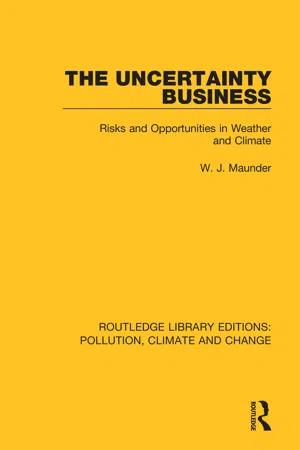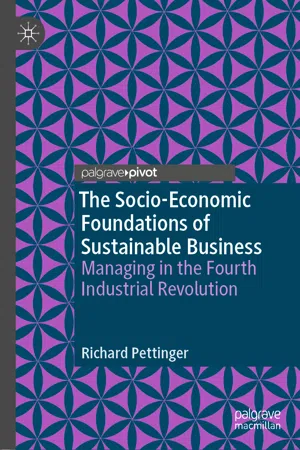Economic Climate
The economic climate refers to the overall state of the economy, including factors such as inflation, unemployment, consumer confidence, and business activity. It provides a snapshot of the current economic conditions and influences business decision-making, investment strategies, and market trends. Understanding the economic climate helps businesses anticipate potential challenges and opportunities in the marketplace.
6 Key excerpts on "Economic Climate"
- eBook - ePub
The Human Impact of Climate Uncertainty
Weather Information, Economic Planning, and Business Management
- W. J. Maunder(Author)
- 2019(Publication Date)
- Routledge(Publisher)
...Chapter II THE CHANGING Economic Climate A. The Real Economic Climate 1. Area, Time, and Business Aspects The phrase ‘Economic Climate’ is a favourite expression amongst politicians, economists, company directors, and the news media. But what is the true ‘Economic Climate’ of a nation? Websters’s dictionary gives one definition of climate as: ‘the prevailing temper or environmental conditions characterizing a group or period’, which suggests that the ‘true’ Economic Climate involves consideration of not only the political, social, and economic life of a nation, but also environmental factors which should include the weather and the climate. For example, the Financial Times reported on 14 December 1985 that coffee prices had been rising virtually without interruption all that week on the London and New York futures markets in anticipation of severe drought damage next year to the Brazilian crop, with the London futures market closing at £2,148 pounds per tonne, upon the week by £99 per tonne, its highest level for six months. But few substantial studies have been completed on the specific effects of weather on business. Indeed it is paradoxical that the value of information about the weather and climate to business and commercial activities appears to be ignored, not only by many meteorologists and climatologists, but also by the business community. The relatively flourishing consulting activities performed by meteorologists in the United States and a few other countries are exceptions; indeed, they provide clear evidence that some astute business enterprises are willing to pay good money to know more about how weather and climate influences their business. The value of weather and climate to an area requires the identification of activities that are affected directly or indirectly by the weather and climate, and an analysis of the manner in which a specific change results in gains or losses to such activities...
- eBook - ePub
The Uncertainty Business
Risks and Opportunities in Weather and Climate
- W. J. Maunder(Author)
- 2019(Publication Date)
- Routledge(Publisher)
...Furthermore, provided appropriate analyses have been made, these weather data can be converted in real-time into economic impacts and can therefore become estimates of that part of the economy that is affected by the weather and the climate. Accordingly, when weather and climate is a limiting factor its impact is known immediately. Thus a forecast of economic data – which at the time the forecast is made do not actually exist or more correctly have not been compiled, collected, or analysed – can be made using real-time weather and climate data. Moreover, because climate is outside the economic system, its direct effects are easier to measure than the effects of other economic variables. H. Climatic solutions to problems A key aspect of climate and socio-economics is ‘what is your problem?’ followed by the even more important question, ‘is there a climate solution to this problem?’ That is, would an appropriate analysis of weather and climate information be of assistance in providing a better understanding of this problem? Consider for example the problem of agriculture (Fig. IV.4). In general the environment can be said to influence production. More specifically one can define the biological response to a variation in the environment. For example, very dry conditions may decrease wool production but increase wool quality, while colder than average temperatures may decrease corn production but increase potato production. The significant question then follows: ‘what does the farmer, farm adviser, agricultural producer board official, or government Secretary of Agriculture, do?’ As shown in Fig. IV.4 one can either do nothing and therefore accept the economic, social, and political consequences, or one can act. In the case of agriculture at least four options of ‘doing something’ are available...
- eBook - ePub
- Wim Hulleman, Ad Marijs(Authors)
- 2021(Publication Date)
- Routledge(Publisher)
...1 Economics and the business environment 1.1 Economic activity and economics 1.2 Business environment 1.3 Absolute and relative data What is economic activity and what academic discipline studies it? What is the relationship between the business environment and economics? Economic phenomena are regarded as belonging to the so-called business environment. This chapter will address the following key question: what role does economics play in the business environment? On the next page, a situational sketch is used by way of an introduction to these issues. People always have needs of one form or another, and they fulfil these needs with available resources. This is termed economic activity. Economic activity is the subject of many branches of economic research, and is dealt with in Section 1.1. Section 1.2 deals with the objectives of economics within the framework of the business environment. It delineates that business environment with these objectives in mind. The main issue is what external factors determine business results. Political developments in market areas, technical innovations, major shifts in customer demand and changes in work ethics all have a major effect on companies. The contribution that economics could make to analysing these aspects is illustrated in a diagram. Section 1.3 treats the relationship between absolute and relative changes in variables. The importance of the absolute change in economic variables will always be manifestly evident (for example, the employment figures over a number of years). However, the relative changes to these variables are often just as significant (for instance, the percentage of employment growth during a specific year). CASE The economic conditions under which the management of an airline have to operate are crucially important. Knowing these conditions can be the key to success...
- eBook - ePub
The Socio-Economic Foundations of Sustainable Business
Managing in the Fourth Industrial Revolution
- Richard Pettinger(Author)
- 2020(Publication Date)
- Palgrave Pivot(Publisher)
...There is also the critical influence that every organisation and its activities has on collective and individual behaviour; and this part of environmental analysis ought to be a key influence on managerial knowledge and expertise. This chapter draws on and develops standard and well known analytical approaches to the organisational and operating environment. It specifically reviews and develops the PESTEL approach to give a much greater emphasis to behavioural, social and technological factors. The Economic Environment The economic environment is the core of the context in which all business, managerial and organisational activities take place. Of key concern are the following: the overall structure of the economic environment, and the mix of commercial, public service and not for profit activities that are conducted; the potential for growth and opportunities; the volumes and value of business conducted; key macro issues including: money supply; interest and inflation rates; the rates of business growth, both overall and also by sector and location; employment rates and density; and unemployment rates and whether unemployment is structural or transitional; pay, wage and salary rates, and the resultant propensities to spend and save; the frequency, value and volumes of business transactions, both overall and also by sector, location and activity; the structure and quality of the business infrastructure, including: transport; access and egress; telecommunications; physical and technological/virtual connectivity; IT systems and other technology; and commercial and domestic property; availability of skilled staff with required and demanded expertise; ‘market rates’ for specific skills and expertise; specific actions taken by national, regional and local government to develop and ‘pump prime’ activities, by sector, location and activities; other impacts and interventions by national, regional and local government and their agencies (e.g...
- eBook - ePub
Doing Business In Latin America
Challenges and Opportunities
- John E. Spillan, Nicholas Virzi, Mauricio Garita(Authors)
- 2014(Publication Date)
- Routledge(Publisher)
...3 THE BUSINESS CLIMATE IN LATIN AMERICA INTRODUCTION The important issues of the Latin American economy pertinent to the foreign investor wishing to do business in the region pertain to the matters of trade. In this chapter, we treat the matters of the increasing involvement of the Latin American countries in the globalized economy, and her continued efforts to pursue economic integration via trade treaties, from the perspective of the investor wishing to do business in Latin America. For this we rely on conventional indicators typically used, such as the Global Competitiveness Index (World Economic Forum), Index of Economic Liberty (Heritage Foundation), the Ease of Doing Business Index (World Bank), and the Human Development Index (United Nations), to name but a few. This chapter gives an overview of the evolution of the Latin American economy and its business climate, to explain how it got to where it is today, and to give a better picture of where it might be going. We begin with the historical perspective of the doing business climate in Latin America, which covers in quick order the legacy of the Import-Substitution-Industrialization (ISI) regimes and the debt crises. This is important to do, because the significance of current trends can be gauged only from this perspective, which takes into account the progress already made. Based on important lessons learned, Latin America has greater macroeconomic stability than either the United States or the Euro Zone countries today. After reading this chapter, the reader should have a strong, general grasp of the broadly considered business climate in Latin America, and the strong commitment and harsh measures that the region has had to demonstrate in order to achieve today what should be considered one of its strongest comparative advantages: a climate conducive to doing business. Latin America has undergone profound changes in its business climate...
- eBook - ePub
- Rob Dransfield(Author)
- 2013(Publication Date)
- Routledge(Publisher)
...6 Business strategy in an economic context Chapter Outline 6.1 Introduction 6.2 What business strategy involves 6.3 The ingredients of strategy 6.4 The criteria for an effective strategy 6.5 How an environmental analysis helps to determine the suitability of a strategy 6.6 The nature of strategic vision, objectives, focus and architecture 6.7 Business strategy in an economic context 6.8 Summary Chapter Objectives By the end of this chapter you will understand : Why businesses need to have an effective strategy The components that need to be in place to create a business strategy How to judge a strategy in terms of suitability, acceptability and feasibility How to create a PEST analysis Why it is important to evaluate the economic environment and its impact on business strategy 6.1 Introduction Businesses need to have a sense of the direction in which they want to move. Once they are clear about this they can formulate their plans – strategies to achieve their desired goals. However, the process is not as simple as it sounds. Businesses operate in uncertain environments. They need therefore to be continually prepared to adjust their strategies to accommodate for environmental change. Perhaps the biggest uncertainty in the business environment is economic change. This is one of the reasons why an understanding of economics is so important to business students. You need to be able to understand the impact of major macro-economic changes such as changes in the gross domestic product (GDP) of a country, and the relative growth of different economies. This chapter therefore explores corporate strategy in the context of an uncertain economic environment...





